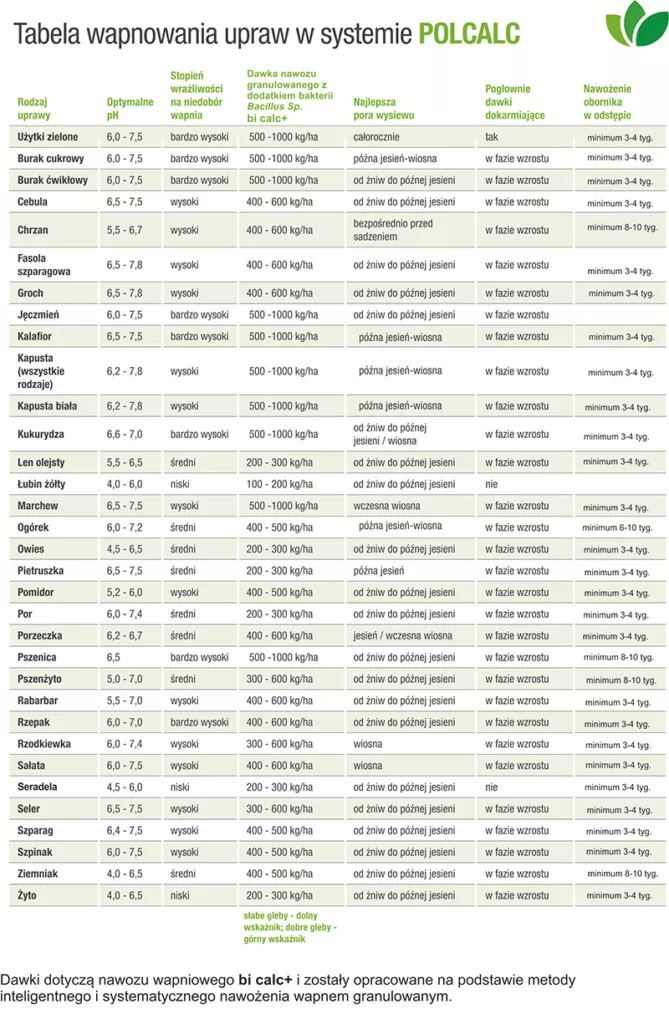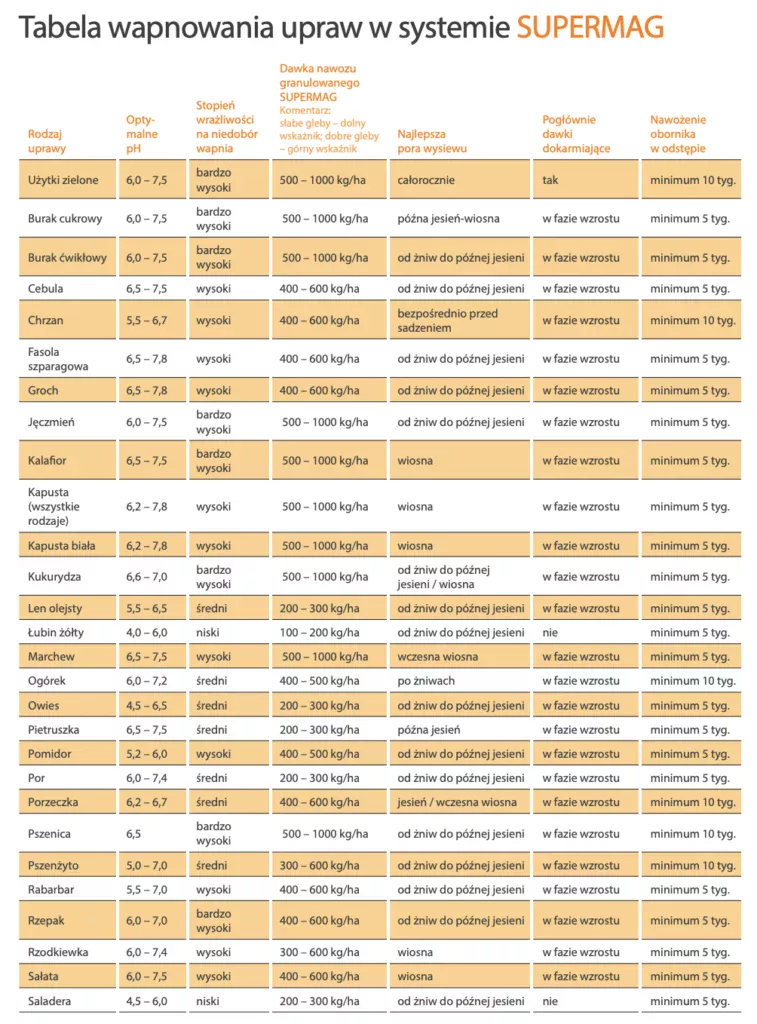
A very important, indeed the most important factor of soil is liming, a process that must be carried out systematically to supplement the necessary calcium for the soil and the plants, and is the main factor of soil deacidification. An important thing to always remember is the alkalinity of our soils, whether it’s a garden plot, a patch of grass around the house, or a large farm. In every situation, we should reflect, observing our piece of land and what is happening with it. Observation teaches and helps to notice changes in plants. As an agronomist, I observe plants, and I can say that everything shows up on them, you just have to observe it and react fairly quickly. After observing the fields I visit, I know that topdressing with lime is the best way to supplement nutrients.
One of the most common methods of liming in Poland is topdressing with lime. Autumn fertilization allows us to spread the component in the fall or, if it’s too dry, to use it along with NPK fertilization in spring when we cannot enter the field because either regulations prohibit us or the weather is unfavorable due to rainfall.
This is definitely a better term than spring because we replenish the lack of lime. However, when deciding on winter liming, we must adhere to several very important rules, namely:
- Liming can only be done on flat fields, then we guarantee that the lime will not be washed away from the field by winter rains or melting snow. Lime sown in winter, thanks to moisture in the soil, will naturally be able to move along with water into the depth of the soil profile;
- Do not lime flooded fields or those covered with a thick layer of snow (a several-centimeter layer of snow should no longer be an obstacle to carrying out the treatment);
- For winter liming, slow-acting carbonate forms of lime fertilizers are recommended, which work better at lower temperatures. In addition, such lime applied to moist soil can remain uncovered for a longer period. On the other hand, we should refrain from using oxide lime, which, when in contact with moisture, will clump;
- The fertilizer dose should be lower than the dose used under normal conditions after harvests, winter liming should be done early in the morning when the soil is still frozen, then we will be able to enter the field without problems, not excessively compacting the soil and not damaging its structure. Remember that frozen soils should not be limed to a depth of more than 25 cm!
The best liming period so far was considered to be the post-harvest period, in practice, the accumulation of fieldwork at that time means that the treatment is not always carried out in time. Later, weather conditions may also not be favorable – we have a different situation every autumn. A high number of rainfall and soil moisture effectively prevented entry into the field or it was too dry, preventing the breakdown of fertilizers. However, it is necessary to deacidify the soil because failing to lime on acidic soil sites will lead to the transformation of aluminum into its toxic forms for plants. Some nutrients, such as phosphorus, will become unavailable to plants. To save the yield in such sites, it is necessary to apply lime topdressing, possibly only using calcium carbonate (CaCO3). Oxide lime (burned, construction) applied topically acts quickly but destroys the crop.
During the vegetation of plants, granular carbonate fertilizer can be used. It is suitable for application in autumn, winter, and early spring and is generally easily absorbed from the top layer of soil (it does not penetrate deeper because it is not mixed with soil). The advantage of granules is the reduction of dusting and more uniform spreading of fertilizer in the field compared to loose forms.
POLCALC III GENERATION, as well as SUPERMAG, has a huge potential for deacidification. Laboratory tests indicate that it allows for the deacidification of about 0.5 kg of soil from pH 4 to pH 7! To properly utilize this potential, several guidelines must be remembered. POLCALC III GENERATION and SUPERMAG are recommended to be used „under the harrow” or topically! To maintain the correctness of the deacidification process, the granules should be evenly spread over the leveled surface of the field. Under the influence of moisture, the fertilizer then breaks down, and, along with rainfall, evenly washes and deacidifies the entire soil profile. Let’s emphasize that this does not cause any loss of active substances due to evaporation or pose any risks to plants; hence the possibility of topdressing both directly and on green areas. Sowing fertilizer „before plowing” reduces the benefits of its application! This significantly worsens the uniformity of the soil deacidification process and delays the disintegration of granules. Winter is undoubtedly a better period for liming than spring. During the winter period, we can use the autumn-winter reserves of water in the soil and gain time by prolonging the contact of lime with the soil. Liming during the winter period is usually applied before sowing corn, and spring cereals, and in smaller doses before beets. It is not recommended to use lime under plants that do not like freshly limed sites such as potatoes, oats, or lupines. We often apply lime to intercrops left for the winter, which will be plowed in spring.
In summary, let’s not be afraid to use lime topdressing on plants because it will only help them, not harm them.
Tabela 1.
Orientacyjne dawki granulowanego wapna nawozowego Polcalc III Generacji. Dawki dotyczą wyłącznie nawozów wapniowych POLCALC III GENERACJI® i zostały opracowane na podstawie metody inteligentnego i systematycznego nawożenia wapnem granulowanym.

Tabela 2.
Orientacyjne dawki granulowanego wapna magnezowego SuperMag. Dawki dotyczą wyłącznie nawozu SuperMag i zostały opracowane na podstawie innowacyjnej metody systematycznego nawożenia wapnem granulowanym.







